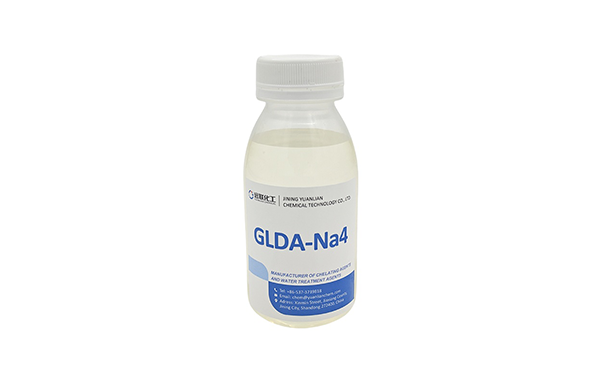
GLDA (Tetrasodium Glutamate Diacetate): The High-Performance, Biodegradable Chelant for Modern Industrial Cleaning
Introduction: The Need for a Sustainable Shift in Industrial Cleaning
Industrial cleaning is a critical process for maintaining operational efficiency, safety, and equipment longevity. However, traditional cleaning chemicals often pose significant environmental and safety challenges. In line with the European Green Deal and stringent REACH regulations, there is a growing demand for high-performance, sustainable alternatives.

Tetrasodium Glutamate Diacetate (GLDA) emerges as a leading solution. Sourced from natural, plant-based amino acids, this readily biodegradable chelating agent delivers outstanding cleaning performance without compromising ecological or workplace safety. This article explores why GLDA is becoming the preferred choice for forward-thinking industries across Europe.
Why GLDA? Key Advantages for Industrial Applications
GLDA's molecular structure, derived from L-Glutamic acid, provides a unique set of benefits that make it ideal for demanding industrial cleaning tasks.
-
Superior Chelating Power
GLDA exhibits an exceptionally high binding affinity for multivalent metal ions, particularly calcium (Ca²⁺) and magnesium (Mg²⁺). Its calcium sequestration capacity surpasses that of many traditional agents like citric acid and is comparable to, or even better than, EDTA in many conditions. This makes it highly effective at dissolving tenacious calcium carbonate scale and other inorganic deposits. -
Excellent Environmental Profile & Readily Biodegradable
This is GLDA's most significant advantage. Classified as readily biodegradable (OECD 301), GLDA breaks down quickly in the environment into water, CO₂, and biomass, leaving no persistent ecotoxic residues. This aligns perfectly with European environmental standards and corporate sustainability goals. -
Broad pH Range Stability
GLDA maintains its chelating efficacy across a wide pH spectrum (from ~4 to 12). This versatility allows it to be formulated into both acidic descalers and alkaline cleaning solutions, providing a single, effective solution for various cleaning protocols, from aggressive boiler cleaning to gentle RO membrane cleaning. -
Outstanding Material Compatibility
Unlike mineral acids, GLDA is non-corrosive to common industrial materials such as carbon steel, copper, and stainless steel when used at recommended concentrations. This ensures thorough deposit removal while protecting valuable assets from damage, thereby reducing maintenance costs and extending equipment service life. -
Enhanced Operator Safety
With a natural, plant-based origin and a favourable toxicological profile, GLDA is safer for handling compared to many synthetic alternatives. It reduces workplace risks and simplifies disposal procedures, contributing to a safer working environment.
Primary Applications of GLDA in Industrial Cleaning
GLDA's balanced profile makes it suitable for a wide range of critical cleaning applications:
-
Boiler and Heat Exchanger Descaling: Efficiently removes hard water scale and deposits, restoring thermal efficiency and reducing energy consumption without risking corrosion damage to high-pressure systems.
-
Reverse Osmosis (RO) and Nanofiltration (NF) Membrane Cleaning: Its high efficiency and gentle nature make GLDA ideal for cleaning sensitive spiral-wound membranes. It effectively removes inorganic foulants without compromising membrane integrity or performance.
-
Cooling Water System Maintenance: Used in both cleaning and treatment programs to prevent scale formation and maintain clean heat transfer surfaces in open and closed-loop cooling systems.
-
Food & Beverage Industry (CIP Cleaning): Its biodegradable nature and origin from a food-grade amino acid make it a safe and sustainable choice for Clean-in-Place (CIP) processes, ensuring no harmful residues.
-
Metal Surface Pre-Treatment: Effectively sequesters water hardness ions during cleaning and rinsing stages, preventing spot formation on metal surfaces before electroplating or painting.
GLDA vs. Traditional Chelating Agents: A Comparative Analysis
| Feature | GLDA | EDTA | NTA | Citric Acid |
|---|---|---|---|---|
| Biodegradability | Readily Biodegradable | Poorly Biodegradable | Ultimately Biodegradable | Readily Biodegradable |
| Chelating Strength (Ca²⁺) | Excellent | Excellent | Good | Moderate |
| Environmental Impact | Very Low | High (Persistent) | Moderate (Controversial) | Very Low |
| Feedstock | Plant-Based, Renewable | Petroleum-Based | Petroleum-Based | Plant-Based, Renewable |
| Material Safety | Excellent | Good | Good | Can be Corrosive |
This comparison clearly shows that GLDA offers the best combination of cleaning performance and sustainability.
Conclusion: GLDA - The Intelligent Choice for Efficient and Sustainable Industrial Cleaning
In conclusion, Tetrasodium Glutamate Diacetate (GLDA) represents a paradigm shift in industrial cleaning chemistry. It successfully bridges the gap between the uncompromising demand for operational efficiency and the pressing need for greener, safer industrial practices.
For European industries aiming to enhance their environmental stewardship while maintaining peak performance, adopting GLDA-based cleaning formulations is a strategic and responsible decision. It is not just a cleaning agent; it is a tool for achieving sustainability targets and building a cleaner, more efficient industrial future.
Yuanlian Chemical specializes in the production of polyaspartic acid (PASP),tetrasodium iminodisuccinate(IDS), GLDA, MGDA etc. with stable quality and excellent quantity!





Contact us